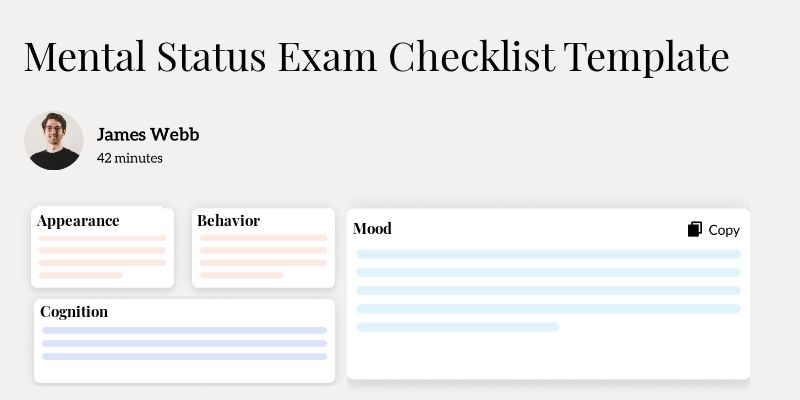
Mental Health Risk Assessment Template
Have you ever felt overwhelmed by the many aspects of mental health assessment? You're not alone! Many practitioners find it challenging to effectively and efficiently evaluate mental health risk in their patients. The right tools can make all the difference, and that's where the Mental Health Risk Assessment Template comes into play. This guide will help you navigate the essential components, tips, and real‑life applications of this invaluable resource.
What Is a Mental Health Risk Assessment Template?
A Mental Health Risk Assessment Template is a structured tool designed to help healthcare providers systematically evaluate the potential risks associated with a patient's mental health condition. This template streamlines the assessment process, ensuring that all relevant factors are considered.
By leveraging such a template, professionals can enhance their documentation practices and create a clear baseline for ongoing patient care. The aim is to identify any immediate and long‑term threats to a patient's well‑being, allowing for timely intervention.
Key Components of a Mental Health Risk Assessment
The effectiveness of a mental health risk assessment relies on several key components:
- Patient demographics
- Presenting concerns
- Psychiatric history
- Current mental state examination
- Risk factors (e.g., suicidal ideation, substance abuse)
- Protective factors (e.g., support systems, coping mechanisms)
- Recommendations for follow-up interventions

How to Use a Mental Health Risk Assessment Template: Step-by-Step Process
- Gather necessary patient information including demographics and medical history.
- Clearly outline the presenting concerns to frame the assessment appropriately.
- Conduct a mental state examination, noting key observations.
- Identify risk factors that may contribute to mental health deterioration.
- Evaluate protective factors that may mitigate risks.
- Document findings and outline recommendations for intervention or follow-up.
Benefits of a Mental Health Risk Assessment Template
Benefit | Description |
|---|---|
Standardization | Ensures consistent assessments across different practitioners and settings. |
Efficiency | Saves time by providing a clear framework for assessment. |
Comprehensive Evaluation | Facilitates thorough examination of risk and protective factors. |
Improved Documentation | Enhances clarity and completeness of patient records. |
Better Outcomes | Leads to more accurate identification of patients in need of intervention. |
Stakeholders in Mental Health Risk Assessment
Multiple parties benefit from a comprehensive mental health risk assessment:
- Patients: Receive tailored care based on thorough assessments, leading to better health outcomes.
- Healthcare Providers: Improve their clinical efficiency and documentation practices through the use of standardized templates.
- Psychiatrists: Gain insights into complex cases, allowing for informed treatment decisions.
- Insurance Companies: Benefit from comprehensive data, allowing for appropriate coverage and reimbursements.
Example of a Mental Health Risk Assessment Template
This template typically includes sections for demographics, presenting issues, clinical evaluation, and recommendations. It serves as a guide for practitioners during evaluations.
Real-World Use Cases: Practical Impact of the Mental Health Risk Assessment Template
- Therapy: a therapist working with a patient who has a history of anxiety found that the template helped identify recent triggers, leading to an actionable treatment plan.
- Psychiatry: A psychiatrist use the assessment form to clearly categorize risk factors for a patient experiencing mild suicidal ideation, enabling effective intervention.
- Social Work: A community health worker employed the template to assess multiple individuals in a group setting, ensuring that everyone received appropriate follow-up care based on their unique needs.
Conclusion
The use of a Mental Health Risk Assessment Template enhances the effectiveness of mental health evaluations by providing structured and standardized approaches to risk identification. Key points include the importance of thorough patient history, key components that ensure comprehensive evaluations, and the benefits of using such a template. By simplifying the assessment process, healthcare providers can contribute to improved patient outcomes and offer a higher standard of care.
Disclaimer: This article is for informational purposes only and does not constitute legal or medical advice. Always consult professional guidelines and regulatory bodies for specific compliance requirements.

Dr. Danni Steimberg
Dr. Danni Steimberg is a pediatrician at Schneider Children’s Medical Center with extensive experience in patient care, medical education, and healthcare innovation. He earned his MD from Semmelweis University and has worked at Kaplan Medical Center and Sheba Medical Center.
- Always gather comprehensive patient history before starting the assessment.
- Include standardized questions to ensure consistency across evaluations.
- Make use of clear and concise language to enhance patient understanding.
- Regularly review and update your template based on the latest evidence and best practices.
- Engage in active listening during assessments to capture nuanced information.
Frequently Asked Questions
Reduce burnout,
improve patient care.
Join thousands of clinicians already using AI to become more efficient.

Mental Status Exam Checklist Template
Discover practical Mental Status Exam Checklist Template templates to enhance your documentation efficiency.

Treatment Summary Template
Discover practical Treatment Summary templates to enhance your documentation efficiency.

Symptom Tracker Template
Discover practical Symptom Tracker templates to enhance your documentation efficiency.

